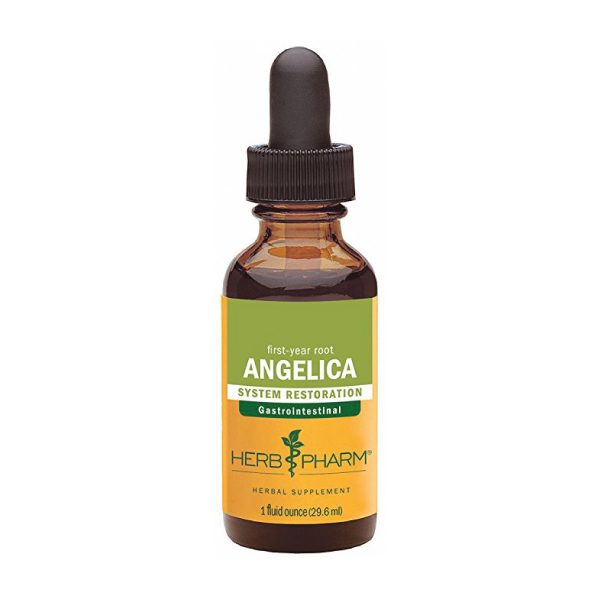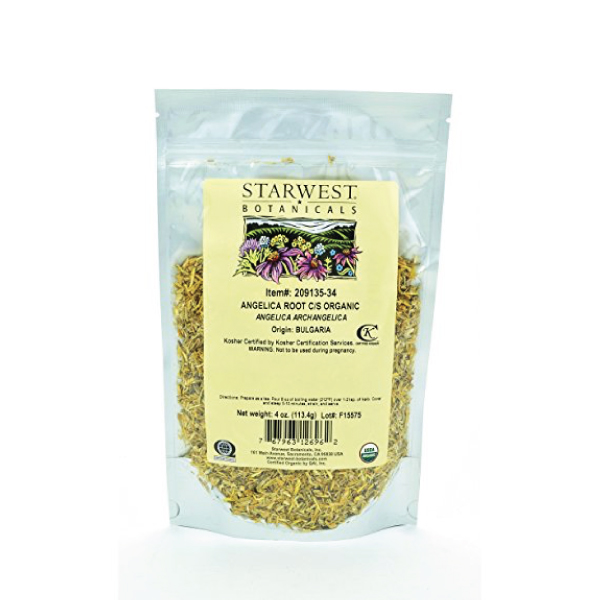What is Angelica?
Angelica seeds are a common ingredient in alcoholic beverages including chartreuse and gin for their aromatic nature.
Both the roots and seeds are used as medicine.
Angelica roots and seeds are both potent antispasmodics, and are useful in treating mucle cramping and period pains. They're also bitter, making them useful for stimulating digestion.
One of the best uses for angelica though are for its antibacterial actions. In the times of the black plague, angelica was said to have been brought to humans by an angel as a cure, hence the botanical name Angelica archangelica.
What Is Angelica Used For?
Muscle cramps, period pains, indigestion, bacterial infection of the gastrointestinal tract.
Traditional Uses of Angelica
+ Traditional Chinese Medicine:
Drains the yin, awakens the appetite, invigorates the spleen, stomach, and intestines, and dispels mucous damp conditions [9]. It is as such beneficial in all yin excess conditions, such as cold, damp, and phlegm congestion in the lungs, intestines, and uterus [9, 12].
Herb Details: Angelica
Herbal Actions:
- Antispasmodic
- Carminative
- Cholagogue
- Bitter
- Antibacterial
- Anticancer
Weekly Dose
- (1:2 Liquid Extract)
5-20 mL - View Dosage Chart
Part Used
Seeds, root, essential oil, leaves
Family Name
Apiaceae
Distribution
Throughout Europe, Northern India
Constituents of Interest
- Angelic acid
- Valeric acid
- Angelicin
Common Names
- Angelica
- Chorak
CYP450
- Unknown
Quality
- Warm
Pregnancy
- Unknown
Taste
- Bitter, Aromatic
Duration of Use
- Long term use is acceptable
Products Containing Angelica
Botanical Information
There are 30 species of Angelica. The most commonly used are Angelica sinensis (Dong Quai), and Angelica archangelica.
The Apiaceae family of plants, under which Angelica is contained, consists of 3700 species distributed into 434 genera. It's the 16th largest family of flowering plants.
Angelica is a biennial (or perennial) herb, that can grow up to 2m in height [9].
Habitat Ecology, & Distribution
Angelica archangelica is commonly cultivated on a large scale in Belgium, Holland, France, Germany, Hungary, and northern India [10].
Harvesting Collection, & Preparation
After harvesting or acquiring fresh Angelica roots, they should be dried rapidly and stored in air tight containers. Here they will store for many years. [3]. The preferred age of the roots before harvesting and use is 2 years or less. Older roots is considered inferior and lacks the peppery top note often desired from the younger root but can still be used medicinally. [9].
Alcohol should be used to extract the medicinal components rather than water [3].
The essential oil is obtained from the roots via steam distillation.
The stems of Angelica are popular when candied. [3].
Pharmacology & Medical Research
+ Anticonvulsant
Studies done investigating the essential oil of Angelica archangelica found that it exhibits significant anti-seizure activity against chemically and electrically induced convulsions in mice [8].
Phytochemistry
+ Full List
- Volatile oil (roots) (1%) [9]
- pentadecanolide
- tridecanolide
- rho-cymen-8-ol
- alpha-bisabolene
- bornyl cryptone
- copaene
- terpinolene
- p-cmene
- trans-ocimene
- cis-ocimene
- beta-phellandrene
- limonene
- myrecene
- alpha-phellandrene
- sabinene
- camphene
- alpha-pinene
- Hydroxymyristic acid (seeds)
- Methyl-ethylacetic acid (seeds)
- Terbangelene
- Valeric acid
- Angelic acid
- Sugar
- A bitter pronciple
- Resin
- Angelicin
- Sterols
- Phenolic acids
- Fatty acids
- Coumarins
- Furanocoumarins
- Sugars
- Tannins
Clinical Applications of Angelica:
Angelica seed is effective for treating convulsions due to seizures, period cramps, and muscle cramping. The antibacterial profile of this plant has not yet been confirmed fully.
Cautions:
Angelica is suggested by traditional medical texts to be a uterine stimulant and should not be used during pregnancy.
The furanocoumarin content can cause photo-toxicity in the skin, avoid angelica if high sun exposure is to be expected.
Synergy
Commonly mixed with Juniper for their similar flavours in such preparations as gin [3].
Recent Blog Posts:
References:
Salikhova RA, Poroshenko GG. (1995). Antimutagenic properties of Angelica archangelica L. Vestn Ross Akad Med Nauk. 1:58-61.
Khayyal MT, el-Ghazaly MA, Kenawy SA, Seif-el-Nasr M, Mahran LG, Kafafi YA. (2001). Antiulcerogenic effect of some gastrointestinally acting plant extracts and their combination. Arzneimittelforschung 51:545-53.
A Modern Herbal. (1931). Angelica. Retrieved from http://www.botanical.com/botanical/mgmh/a/anegl037.html
Yeh ML, Liu CF, Huang CL, Huang TC. (2003). Hepatoprotective effect of Angelica archangelica in chronically ethanol-treated mice. Pharmacology 68:70-3.
Sigurdsson S, Ogmundsdottir HM, Gudbjarnason S. (2004). Antiproliferative effect of Angelica archangelica fruits. Z Naturforsch [C] 59:523-7.
Sigurdsson S, Ogmundsdottir HM, Hallgrimsson J, Gudbjarnason S. (2005). Antitumour activity of Angelica archangelica leaf extract. In Vivo. 19:191-4.
Sigurdsson S, Ogmundsdottir HM, Gudhjarnason S. (2005). The cytotoxic effect of two chemotypes of essential oils from the fruits of Angelica archangelica L. Anticancer Res. 25B:1877-80.
Shalini Pathak, M. Wanjari, S. Jain and M. Tripathi. (2010). Evaluation of antiseizure activity of essential oil from roots of Angelica archangelica Linn. in mice. Indian Journal of Pharmaceutical Sciences. 72(3).
Battaglia, S. (2003). The Complete Guide to Aromatherapy (2nd ed.). Brisbane, Australia: The International Centre of Holistic Aromatherapy. (Pg 160-162)
Arctander S. (1994). Perfume and flavour materials of natural origin, Allured publishing, USA.
Grieve M. (1931). A modern herbal. Penguin Publishing, England.
Holmes P. (1989). The energetics of western herbs Vol 1. Artemis press, USA.













As COVID-19 continues to spread around the world, we’re getting a lot of questions on what the potential role of herbal medicine is during the outbreak. Learn how the virus works and how to limit your chances of transmission.